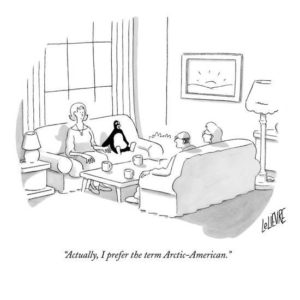The above cartoon was featured in the Feb. 5, 2007 copy of The New Yorker. With its witty humor, the cartoon appeared funny to most readers. Until the magazine received an unexpected comment.
“There are no penguins in the Arctic,” replied a biologist.
While this is a light-hearted example, fact-checking and including scholarly sources is no laughing matter. Coinciding with core practice #9—providing resources that build on or augment your own experience—fact-checking and resourcing provide the trampoline for writer’s to jump their arguments from. We’ll help ensure you stick the landing rather than fly into the bushes.
In his interview with the Columbia Journalism Review, New Yorker fact-checker Peter Canby describes the importance of thoroughness. Canby states, “For us the bigger complexity is what we think of as fact-based opinions. The way you construct an argument, if there are egregious missing ingredients to it, then it’s something we bring up.” When providing resources, it is important that these resources are factual and provide accurate support for your argument. That includes providing scholarly sources, whether found via print formats, online journals, through the DePaul library database, or even Google Scholar.
Pro tip #1: on Google Scholar, check to see how many times a source has been cited in other articles to further ensure credibility.
With the digital age, does fact-checking and research sourcing become easier or more complicated? Cyberspace allows for easier access to information, but also easier access to false or biased information. In their article “Net Gains: Journalism’s Challenges in the Digital Age,” J.D. Lasica explains how effectively using the Internet involves both finding and vetting information. With the rise of fake news, politically-biased blogs and unwarranted commentary, Internet sources undergo additional scrutiny for journalists and scholarly writers alike. When searching for resources online, use verified search engines and databases like DePaul’s A-Z Databases or search for websites that end in .org. While Wikipedia may appear like the Garden of Eden for easily-accessible information, it’s user-provided content can oftentimes be incorrect.
Pro tip #2: If looking on Wikipedia, scroll through the listed references for the same information the web page cited, but from a more credible source.
Journalism is based on ethics—if a news outlet is not truth-telling and transparent, it loses its credibility as a publication. These same concepts apply with academic writing. If an argument is not supported, why should a reader believe it? The Society of Professional Journalists’ Code of Ethics stresses to “seek truth and report it” and “be accountable and transparent.” Truth includes researching and sourcing; being transparent includes acknowledging these sources, whether through textual references or citations. Citing sources that support your argument not only shows readers you did your research, but it allows and encourages them to continue their own, as well.
Pro Tip #3: When including citations, whether MLA, APA, Chicago, etc., stop by your local library for help with proper citations. Oftentimes, they will have example sheets or web pages outlining various citation styles. If you’re in a jam or late-night cram, check out online resources such as PurdueOwl or DePaul’s own UCWbL.
Once the sources are found, the paper is written, and writers are ready to hit that beautiful blue “Submit” button on D2L. Fact-checking is the final step to an “A” paper. Journalists Bill Kovach and Tim Rosenstiel provide techniques for verifying sources in their book “The Elements of Journalism.” Reread a paper before submitting. When you make a claim, ask “how do I know this?” This will ensure you have enough explanation and research to support your argument. Rereading will also help catch small, grammatical mistakes. Additionally, give the paper to a friend and have them search for sources as well since we often become immune or blind to our own writing once we have focused on the topic for extended periods. Finally, try an accuracy checklist by comparing your paper to the provided prompt. Did you meet all the sourcing requirements? Did you answer the prompt clearly and meet all of the criteria?
Pro Tip #4: When rereading your paper, highlight each argument you make. Then, look at the paragraph and ask, “do I have a source to pair with this statement?” This will ensure you are providing ample resources!
For additional information on my sources and research process, view my Prezi below:
http://prezi.com/brlxini7vmoj/?utm_campaign=share&utm_medium=copy&rc=ex0share
Discover more from UCWbLing
Subscribe to get the latest posts sent to your email.



